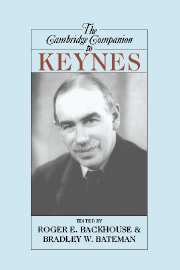Book contents
- Frontmatter
- 1 A cunning purchase: the life and work of Maynard Keynes
- 2 The Keynesian revolution
- 3 Keynes and the birth of modern macroeconomics
- 4 Keynes as a Marshallian
- 5 Doctor Keynes: economic theory in a diagnostic science
- 6 Keynes and British economic policy
- 7 Keynes and Cambridge
- 8 Keynes and his correspondence
- 9 Keynes and philosophers
- 10 Keynes’s political philosophy
- 11 Keynes and probability
- 12 The art of an ethical life: Keynes and Bloomsbury
- 13 Keynes and ethics
- 14 Keynes between modernism and post-modernism
- 15 Keynes and Keynesianism
- Bibliography
- Index
12 - The art of an ethical life: Keynes and Bloomsbury
Published online by Cambridge University Press: 28 November 2006
- Frontmatter
- 1 A cunning purchase: the life and work of Maynard Keynes
- 2 The Keynesian revolution
- 3 Keynes and the birth of modern macroeconomics
- 4 Keynes as a Marshallian
- 5 Doctor Keynes: economic theory in a diagnostic science
- 6 Keynes and British economic policy
- 7 Keynes and Cambridge
- 8 Keynes and his correspondence
- 9 Keynes and philosophers
- 10 Keynes’s political philosophy
- 11 Keynes and probability
- 12 The art of an ethical life: Keynes and Bloomsbury
- 13 Keynes and ethics
- 14 Keynes between modernism and post-modernism
- 15 Keynes and Keynesianism
- Bibliography
- Index
Summary
Keynes is the only major economist who spent a substantial part of his life embedded (in all the meanings of that term) in a community of artists and creative writers. The most important of these for Keynes were members of the so-called Bloomsbury Group: the artists Duncan Grant, Vanessa Bell, Roger Fry and Dora Carrington; the novelists E. M. Forster, Virginia Woolf and David Garnett; the critics Lytton Strachey, Clive Bell and Desmond McCarthy; and others. To disentangle the impact of Bloomsbury on Keynes from other influences is difficult. Many have worked on the question, notably the biographers of Keynes, Harrod (1951), Moggridge (1992) and Skidelsky (1983, 1992 and 2000), who have examined the complex personal interactions. Others, such as Williams (1980), Annan (2002) and Mini (1991), have pictured Bloomsbury as an intellectual community with deep roots in British cultural history. They have documented, for example, how Keynes's close involvement with the artists Grant and Bell, and his great respect for Roger Fry, help to explain his extraordinary commitment to such institutions as the London Artists Association, the Contemporary Art Society, the Cambridge Arts Theatre and the Arts Council. But was Keynes's professional life as well as his personal life affected by Bloomsbury?
- Type
- Chapter
- Information
- The Cambridge Companion to Keynes , pp. 217 - 236Publisher: Cambridge University PressPrint publication year: 2006
- 13
- Cited by

